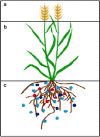Fate of nitrogen in agriculture and environment: agronomic, eco-physiological and molecular approaches to improve nitrogen use efficiency
- PMID: 33066819
- PMCID: PMC7565752
- DOI: 10.1186/s40659-020-00312-4
Fate of nitrogen in agriculture and environment: agronomic, eco-physiological and molecular approaches to improve nitrogen use efficiency
Abstract
Nitrogen is the main limiting nutrient after carbon, hydrogen and oxygen for photosynthetic process, phyto-hormonal, proteomic changes and growth-development of plants to complete its lifecycle. Excessive and inefficient use of N fertilizer results in enhanced crop production costs and atmospheric pollution. Atmospheric nitrogen (71%) in the molecular form is not available for the plants. For world's sustainable food production and atmospheric benefits, there is an urgent need to up-grade nitrogen use efficiency in agricultural farming system. The nitrogen use efficiency is the product of nitrogen uptake efficiency and nitrogen utilization efficiency, it varies from 30.2 to 53.2%. Nitrogen losses are too high, due to excess amount, low plant population, poor application methods etc., which can go up to 70% of total available nitrogen. These losses can be minimized up to 15-30% by adopting improved agronomic approaches such as optimal dosage of nitrogen, application of N by using canopy sensors, maintaining plant population, drip fertigation and legume based intercropping. A few transgenic studies have shown improvement in nitrogen uptake and even increase in biomass. Nitrate reductase, nitrite reductase, glutamine synthetase, glutamine oxoglutarate aminotransferase and asparagine synthetase enzyme have a great role in nitrogen metabolism. However, further studies on carbon-nitrogen metabolism and molecular changes at omic levels are required by using "whole genome sequencing technology" to improve nitrogen use efficiency. This review focus on nitrogen use efficiency that is the major concern of modern days to save economic resources without sacrificing farm yield as well as safety of global environment, i.e. greenhouse gas emissions, ammonium volatilization and nitrate leaching.
Keywords: Ammonium; Assimilation; Enzyme; Fertilizer; Nitrate; Nitrogen use efficiency.
Conflict of interest statement
All authors declared no conflict of interest.
Figures






References
-
- Stitt M, Krapp A. The interaction between elevated carbon dioxide and nitrogen nutrition: the physiological and molecular background. Plant Cell Environ. 1999;22:583–621. doi: 10.1046/j.1365-3040.1999.00386.x. - DOI
Publication types
MeSH terms
Substances
Grants and funding
- 2019YFD1000503/National Key R&D Program of China
- GKAD17195100/Guangxi Special Fund for Scientific Base and Talent
- gjnytxgxcxtd-03-01/Guangxi Sugarcane Innovation Team of National Agricultural Industry Technology System
- 2019/Fund for Construction of Guangxi Key Laboratory of Sugarcane Genetic Improvement
- 2015YT02/Fund of Guangxi Academy of Agricultural Sciences
LinkOut - more resources
Full Text Sources
Other Literature Sources

